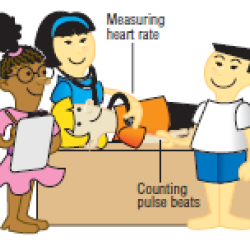Source Institutions
Source Institutions
Add to list Go to activity
Activity link broken? See if it's at the internet archive

In this activity about how the body regulates blood pressure (page 117 of the PDF), learners make and compare measurements of heart rate and blood pressure from three body positions: sitting, standing, and lying. Learners are also challenged to think about how the circulatory system might behave in a microgravity environment (i.e. astronauts in space). The lesson guide, part of NASA's "The Brain in Space: A Teacher's Guide with Activities for Neuroscience," includes background information, evaluation strategies, and handouts. Note: cost of materials does not include cost of stethoscope or sphygmomanometer; these may be borrowed from a nurse.
- Under 5 minutes
- 30 to 45 minutes
- 1 cent - $1 per group of students
- Ages 8 - 18
- Activity, Experiment/Lab Activity, Lesson/Lesson Plan
- English
Quick Guide
Materials List (per group of students)
- Watch or access to clock with a second hand
- Stethoscope
- Sphygmomanometer (an instrument for measuring arterial blood pressure consisting of an inflatable blood pressure cuff, inflating bulb and a gauge showing the blood pressure)
- Alcohol wipes to clean stethoscope ear plugs after each use
- Copy of Activity Sheet: "Changing Body Positions"
- Table or bench long enough for a student to lie down
Subjects
-
Life Sciences
-
Human Body
- The Brain and Nervous System
- Circulation
- Health and Nutrition
-
Human Body
-
Mathematics
-
Data Analysis and Probability
- Data Analysis
- Data Collection
- Data Representation
-
Measurement
- Rate
-
Data Analysis and Probability
-
Physical Sciences
-
Motion and Forces
- Gravity
-
Motion and Forces
-
The Nature of Science
-
The Scientific Process
- Conducting Investigations
- Gathering Data
- Formulating Explanations
- Communicating Results
-
The Scientific Process
Audience
To use this activity, learners need to:
- see
- read
- hear
- be mobile
- touch
Learning styles supported:
- Involves teamwork and communication skills
- Involves hands-on or lab activities
Other
Includes alignment to state and/or national standards:
This resource is part of:
Access Rights:
- Free access
By:
- MacLeish, Marlene Y. ; McLean, Bernice R.
Rights:
- Public domain, NASA,
